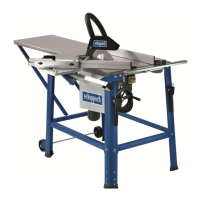19
Make a test cut! Readjust the angle adjustment on the ad-
justing bolts 1 & 2.
Saw Blade Height Adjustment
The saw blade is adjustable from 0 to 80 mm cutting
height after the wing nut has been loosened. For safe and
clean working, choose a minimal saw blade projection for
the workpiece.
Adjust the riving knife as shown in picture 22.
The riving knife is an important safety device which
guides the workpiece and prevents the cutting joint from
closing behind the saw blade and the workpiece from
being kicked backwards. Check the riving knife thickness.
The riving knife should never be thinner than the body of
the saw blade or thicker than the cutting joint width.
Only use saw blades with a diameter of 250 mm and a
thickness of 2.4 mm (3.0 mm teeth).
Lower the suction hood onto the workpiece during every
working cycle. The hood must be positioned horizontally
above the saw blade during every working cycle.
Length Cuts
Insert the length stop for parallel cuts.
Use the stop ruler with the high stop side for cuts above
120 mm and the stop ruler with the low stop side for cut
widths under 120 mm.
Lead the workpiece with the push stick.
1 high hub
2 Iow hub
Diagonal Cuts
For diagonal and angle cuts, insert the cross-cutting
guide.
Operational Information
Working on circular saws
Cutting wide workpieces, Fig. A
Width of the workpiece to be machined over 120 mm
Tool: Circular sawblade for longitudinal cuts
Operating cycle: Adjust the ripping fence in accordance
with the width of the workpiece. Ensure that your hands
are resting in a safe place. The workpiece may only be
forward-fed in the tool area with the right hand or with the
aid of a push-stick if narrow workpieces are cut off in the
cutting process. Move the fence back to the middle of the
saw or use a short auxiliary fence if there is a danger of the
workpiece being jammed between the circular sawblade,
the riving knife and the fence.
Only the upper suction hood has been indicated in the fig-
ures on pages 26-28 or has been left out in the individual
case in order to display the operating cycle or device more
clearly.
The upper suction hood is required for all of the operating
cycles.
Cutting narrow workpieces, Fig. B
Width of the workpiece to be machined less than 120 mm
Fig. C
Fig. D

